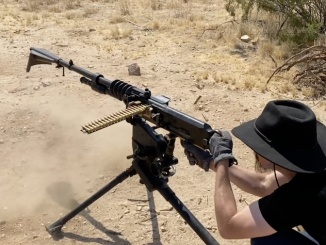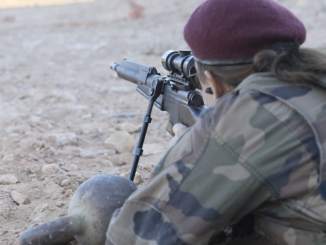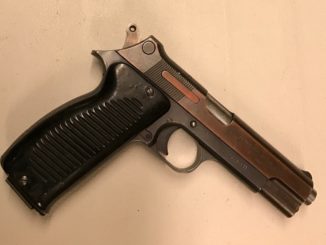When the French first began testing machine guns in the late 1890s, they were one of the few countries that did not purchase quantities of Maxim guns. One of the reasons was that in France’s North African colonies, transporting water for guns was considered an unnecessary liability. Instead, France purchased a number of air-cooled Hotchkiss machine guns for its colonial forces. For the French Metropolitan Army, it wanted a gun designed and produced by its own arsenal system. And so, the Puteaux Arsenal developed the Modele 1905 gun.
This was a gas trap style of action , pulling an operating forward with each shot. The gun was adopted and put into service, and as with every other military user of gas trap guns, the French quickly found the system to be seriously flawed. The St Etienne Arsenal set about improving it, and came up with the Modele 1907, which retained the forward-moving operating rod but used a gas piston instead of a gas trap. This would be the machine gun which France would enter World War One with, and more than 40,000 would be manufactured by 1917.
The Modele 1907 St Etienne gun is a magnificently Victorian machine gun, with a downright Swiss-like rack and pinion system running its action. It would have been truly at home on a Napoleonic battlefield – but not a World War One battlefield. The gun was not well suited to the muddy hell of trench warfare, despite its beautiful machining and quality. Looking for both a lot more guns and also a more field-reliable system, the French began buying a great many Modele 1914 Hotchkiss machine guns, and they would replace the Modele 1907 by the end of the war.
One cannot fault the French for this change, and yet it still seems sad to see such a gorgeous piece of metal fabrication be sidelined – complete with its hydraulically adjustable rate of fire, its fine toothed feed spool, its sights with the spring and lever system to accommodate heat-induced change of aim and its magnificently extravagant flash hider.




High quality madness exceeding that of the Breda 30! But one has to ask why the French government didn’t admit that development from the private sector had gotten much better. Good weapons development requires competition and testing of competing designs, not hegemony or monopoly! Monopolized gun making tends to stagnate progress, especially when money and political influence outweigh the urgency of keeping up with the times. And yet some people still say the government knows best, which I doubt! Since when has a politically backed monopolist in isolation developed a gun that turned out better than other products overseas? I say never, but you can correct me if I’m wrong.
“When has a politically backed monopolist in isolation developed a gun that turned out better than other products overseas?”
The AK-47 / AKM and the PK / PKM come to mind; I’m sure that there are other examples.
That said, keep in mind that the private versus government issue wasn’t really at play at the turn of the 20th century. Practically all states used some combination of private and state procurement; the idea of a socialist government was still very much theoretical, and no one felt any compulsion to purchase from private or public sources for purely ideological reasons.
As Ian pointed out, the French army had some good reasons for preferring their own product – namely, not being reliant on a possibly unreliable commercial supplier for one of the army’s main frontline weapons. Patronage, and desire to create jobs probably also played a role, though this is a problem hardly unique to public-sector suppliers – plenty of bad contracts from private sector suppliers have been justified on the same grounds.
Furthermore, as Ian pointed out, the St. Etienne wasn’t necessarily a terrible weapon; definitely over-complex, but also very well manufactured, and bearing a number of useful features for well-trained operators. The weapon’s misfortune was simply that it was used in a type of warfare that it’s designers never anticipated: mass-attritional fighting by barely-trained conscripts wading through mud, where simplicity and robustness trumped elegance.
Finally, many entities, public and private, simply got things ‘wrong’ in the early years of automatic weapons design. The Austrian Schwarzlose was tough as nails, but had a slow rate of fire, and was basically unsuited for use on aircraft; the Italian Fiat-Revelli, with it’s bizarre en-bloc magazine, was as problematic or worse that the St. Etienne. Basically, before it’s possible to conclude that something is a bad idea, someone has to try it out first.
Mikhail Kalashnikov was HARDLY a hill-top hermit. He was given several captured German guns to use as research material, which meant he was not completely isolated at all (and he had competitors too). When I said “isolation,” I meant TOTALLY CUT OFF FROM THE REST OF THE KNOWN CIVILIZED WORLD AND UNABLE TO INTERACT WITH ANYTHING FROM THE REST OF THE WORLD. Said isolation includes forbidding one’s staff from observing anything that cannot be procured in house. That means you cannot spy on other countries and that you can certainly not sneak a peek at weapons catalogs from competitors!
Alright, but I’m not sure that any mass-produced firearm, anywhere in the world, was ever produced along those criteria. Being influenced by, and borrowing from other is inherent to the process of innovation and creation.
Certainly, you can’t hold this against the St. Etienne. The designers were hardly working in ‘isolation’. If anything, the design process was acutely affected the designer’s knowledge of external developments – namely, as Ian points out, the need to avoid pre-existing patents, of which the designers would have been very much aware.
“(…)AK-47(…)”
Not, in fact there existed competing entries from other design bureaus, see photos here: http://forum.ohrana.ru/ognestrelnoe-oruzhie/thread557.html
“(…)AKM(…)”
Not, in fact there existed competing entry, for more data see: http://modernfirearms.net/assault/rus/korobov-tkb-517-e.html
“(…)PK(…)”
Not, in fact there existed competing entries:
ТКБ-521 by Г.И.Никитин and Ю.М.Соколов
ТКБ-464 by В.И.Силин and В.Ф.Перерушев
2Б-П-10 and 2Б-П-45 by Г.С.Гаранин
АО-29 by Шилин
АО-22 by В.П.Грязев
Thus saying that PK was created in isolation is FALSE.
Г.И.Никитин design used typical for Soviet fire-arms principle of operation, as it was gas-operated, but used own (unique) belt for feeding.
See photos here: https://lib.rus.ec/b/458767/read
such design allows 1-step feed (cartridges goes forward from belt), thus this design belongs to very rarely encountered group of 1-step feeding 7,62x54R machine guns.
Czech UK Vz.59 uses push through with 7.62x54R IIRC.
Pull-push is better feed mechanism as cartridge removal from a belt is done at a peak energy potential of the bolt and actually reduces (somewhat) recoil.
Push through, while enabling easier feed mechanism requires good forward speed by the bolt, which requires stiffer return spring, which requires overgassing weapon to work reliably if dirty (since you have to already fight heavier return spring) which leads to weapon beating itself more, which requires heavier gun to prevent that happening too early in the career.
Blimey! You half hope a little clockwork figure is going to pop out and fan the barrel, or even sing opera!
“magnificently Victorian machine gun, with a downright Swiss-like rack and pinion system running its action”
Aesthetic-wise this McLean (or Maclean?) machine gun:
http://raigap.livejournal.com/385901.html
seems to fit well into “steam-punk”
Machine gun designed by Rube Goldberg.
I would say Heath Robinson https://en.wikipedia.org/wiki/W._Heath_Robinson as being geographic-wise closer.
Ahh – a flash hider! Back in December 2015 I saw a (different) machine gun with a similar device the museum Hôtel Des Invalides, Paris, France and sent Ian a photo asking what he thought that thing at the end was: https://www.flickr.com/photos/28804910@N06/24678863289/in/album-72157664722003265/ and at that time he didn’t know but now we all do!
In the 9th edition of Small Arms of the World, the comment on this beast (by the late W.H.B. Smith, I believe) was that “just about the stupidest thing any arms establishment can do is concoct a design either to avoid patent royalties or for private empire building”. And the St.Etienne Modele 1907 is exactly that.
It takes the basic, mule-stupid, brute-reliable Hotchkiss action, and reverses the piston to be blown forward rather than backward by the gas takeoff. Then it adds a rack-and-pinion of the sort found on later automobile steering systems to reverse the piston’s impulse to drive the bolt.
Adding to the idiocy, it cleverly positions the return spring right where it is most exposed to barrel firing heat, locks it in a box so there’s no way to radiate the heat off, and lets it get re-heat-treated with every burst, a sure way to weaken it.
According to SAotW, the reason this monster ended up in forts was that it was too heavy for mobile field use, and the infantry didn’t want to deal with servicing it and keeping it running. So, the French Army command pronounced it “ideal for fortifications”, which was one of their two standard gambits for ridding themselves of impractical or useless equipment without admitting that they had (bleep)ed up in designing and issuing it in the first place.
The other one was to pronounce the equipment/weapon as “best suited for colonial duty” and shipping it off to Africa or the Indies or etc. for the Legion Etrangere’ and Co. to deal with.
Some weapons, no matter how well-made, are useless gadgets bordering on being a PoS to begin with. The Modele 1907 is one such.
cheers
eon
“(…)Small Arms of the World(…)”
Does is explain why Rate-Of-Fire regulator was implemented in this design? It possibly could easy problem of heating spring to some degree, but doesn’t it introduced problems of its own?
The ROF regulator was copied (in function if not in actual workings) from the one in the original 1884 Maxim, that Sir Hiram eliminated because it was an unnecessary complication and often malfunctioned.
The idea was that you could set the gun for a specific fire rate, feed it from a hopper loaded with belted rounds (on the Maxim), pull the trigger once, and forget it for a while as you were doing something else. It would fire a certain number of r/m, generally enough to deny an area without expending all is ammunition in one long burst.
For a “fortess gun” this actually makes a sort of sense. It allows the gun’s natural vibration (if not locked down on a specific line of ire) to swing it from side to side in its embrasure, splatting anything or anybody unlucky enough to be in front of same.
During WW2, the Germans had a similar “traverser” gadget on the tripod mount for the MG34 and MG42, but it was rarely used, mainly because those two “bullet hoses” tended to exhaust a belt or saddle magazine pretty quickly, and could burn out their barrels doing it.
A water-cooled heavy MG in a bunker or etc. is probably the best thing to use something like a RoF regulator and/or an automatic traverser on, if it even makes sense there, which is debatable.
cheers
eon
“During WW2, the Germans had a similar “traverser” gadget on the tripod mount for the MG34 and MG42”
Soviet forces at one time need to evacuate from Hanko peninsula, however problem emerged: how to evacuate without getting enemy attention? So using whatever was on hand Soviet soldiers crafted some devices firing short bursts, which is in described here: http://sovietguns.blogspot.com/2014/02/musical-maxim.html
they even manage to create dog-actuated machine gun (see description in link), this might have advantage over mechanical/electric devices also described as being less predictable.
Anyway, I would say that similar effect might be achieved without including such solution inside machine gun, instead device similar to synchronizer might be used. Synchronizers were used in WW1 aeroplanes were linked to shaft, they blocked machine gun to avoid firing bullet at own propeller, in this case they could be linked to clock mechanism. Surely such mechanism must be cranked-up to work, but anyway belt length is limit (can’t be too long as it would overloading feed system).
“takes the basic, mule-stupid, brute-reliable Hotchkiss action, and reverses the piston to be blown forward rather than backward by the gas takeoff”
So summing up do NOT fix something if it is not broken
Something must have been good about it. They made 40K of them and kicked Hun arse. The 1914 Hotchkiss gets the glory but the St. Entienne’s hauled the freight. The 1914’s were not even around by late 1917 and up to then the St. Entienne’s had been killing Germans.This could suggest and perhaps is borne out by later development is while the heavy water cooled Maxims were great for mowing down charging Hottentot’s and Fuzzy Wuzzies, the air cooled guns were more efficient in a battle against a “civilized” nation.
“(…)St. Entienne’s(…)”
St. Étienne (2 x n in word, not 3 and E acute not just E)
Oops. Thanks. I looked at it and it didn’t look right when I originally typed it, but I couldn’t see the problem, I focused on the two N’s and missed the n in between the E and T. Old eyes or old brain or both. I do try to get the spelling right.
I don’t think my American keyboard will do the acute symbol over the E. Or can we use E’tienne as a substitute?
Assuming that you are using Windows machine:
For uppercase e acute (É): make sure NumLock is disconnected (lamp off), hold down LALT key, type 0201 on numeric keyboard (that digits on right side), release LALT key, letter should appear
For lowercase e acute (é): make sure NumLock is disconnected (lamp off),
hold down LALT key, type 0233 on numeric keyboard (that digits on right side), release LALT key, letter should appear
Classic Spanish keyboard can also do the job :
It shares a QWERTY base but both accents and ç are available. Accents location corresponds to [ and ; on US Qwerty.
https://www.bridge4mobility.com/wp-content/uploads/teclado-espa%C3%B1ol.jpg
Any chance you can take it out and shoot it,Ian?
Ian’s in love! Let us know if you get this one (admit it – you’re going to bid on it)
When I see this gun, by some inexplicable connection a song comes to my mind:
https://www.youtube.com/watch?v=gjndTXyk3mw
Is it because this gun is as ‘anti-war’ as the song?
🙂
An elegant weapon for a more civilized age. I know that the politicians wanted to look good and keep the peace. They lost both the peace and their pride.
Still trying to grasp the extreme rate reduction. How do you slow fire to 8, or even 50 rounds per minute without having to come to a full stop and have another trigger-pull?
I am not sure how it is done in that machine gun, but early Maxim machine gun discussed here: https://www.forgottenweapons.com/the-first-maxim-machine-gun/
also have adjustable Rate-of-Fire:
rate of fire – which could be as high as 600 rounds/minute and as low as 1 or 2 rounds/minute.
For more data see video in link
A recurring theme on FW is that most innovations have actually been tried elsewhere. The thermal regulation of the front sight must be the exception that proves the rule. The very clever Russians may have tried something like this, so please prove me wrong.
Ian, are we to see the Swiss AK52 with its reciprocating barrel and stationary bolt from the long-ago UK visit as a shoulder-fired encore to this installment?
It’s a true engineers machine gun. All I have to say is Wow!!!
Does the rate change mechanism delay the tripping of the sear? Would releasing and pulling the trigger again fire the gun immediately or would the delay still be in effect?
Thinking rate of fire vs fired at a rate.
Fabricate a clear sideplate and shoot it at 10 RPM…